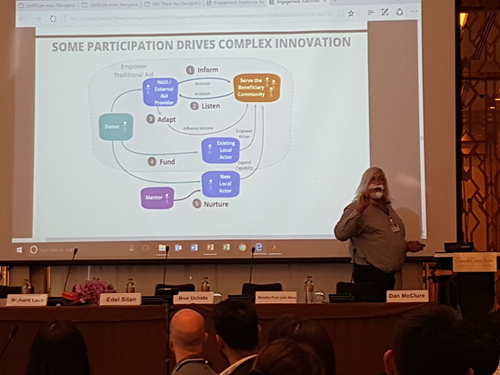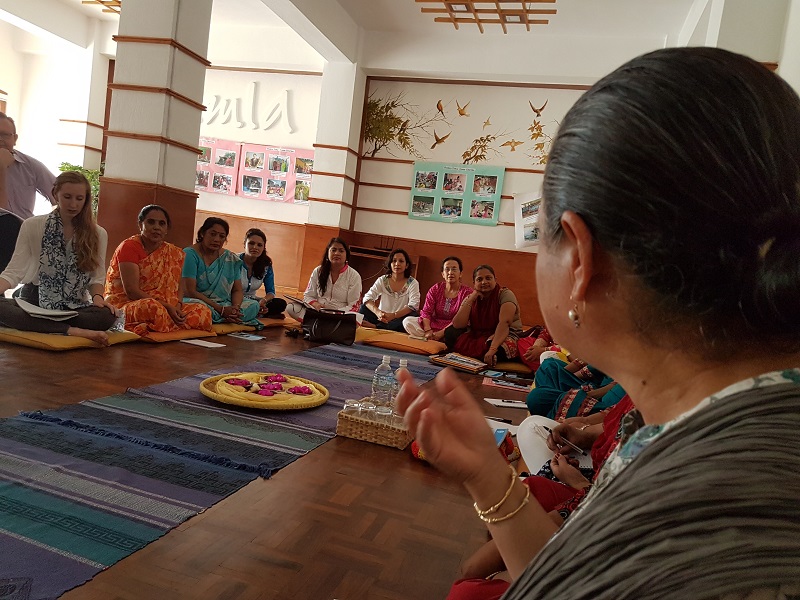What will it take for the humanitarian aid system to #ShiftThePower?
12 Jun 2017
The language was rich with promise – the “Grand Bargain”, the “Participation Revolution.” At the World Humanitarian Summit one year ago in Istanbul, 30 of the biggest donors and aid providers committed to a series of actions aimed at getting more money to local NGOs on the frontlines of humanitarian relief. To put things in perspective, at present less than 1% of development aid goes directly to southern organizations.
A year on, how is it all going? Is the bargain really being struck? Has the revolution started?
In May, the CDAC Network (“Communicating with Disaster-Affected Communities”) and the Steering Committee for Humanitarian Response (SCHR) held a Global Forum in Bangkok aimed at reflecting on progress so far. The conversation got off to a brisk – but rather sobering – start, with the announcement that the participation revolution was not happening and that fundamental change was (still) going to be required to avoid a “Grand Bargain” for business as usual. Kate Halff (SCHR) laid out the challenge: mindsets and organizational cultures needed to change, the conversation had to be about more than money and become much more people-centred. Organizations in the humanitarian space had to be more open to working with new, perhaps non-traditional, partners, and finally, the humanitarian aid system overall should be prepared to give up some of its power.
So much for the diagnosis.
Over the course of the two days, I looked hard for evidence that change was underway. Amidst the soul-searching, the head-scratching, the bright spots, signs of progress, and some great insights on systems change, there were less encouraging moments of back-pedalling (“I prefer to think of evolution rather than revolution”) or a simple lack of imagination (“We can do more feedback..?”). It’s clear there are some practical objections to any radical change, as well as deeper intellectual, or even existential, issues, well fleshed-out here.
More Blobs, Fewer Squares…
What struck me, an interloper, at the Bangkok Forum – and also at the recent START Network Members’ Day – was the apparently limited menu of actors in the humanitarian universe. I was reminded of the wonderful Parable of the Blobs and Squares (an ode to the virtues of co-creation) and was struck by how heavy the makeup of the room at both meetings was on the “square” front and how light on “blobs.” The landscape for humanitarian aid and development has changed dramatically in recent years; it is now more complex than ever, with diminishing flows of money from traditional donors, the emergence of new “non-traditional” actors – including the growing local philanthropic sectors, which forms a critical part of the landscape in which the GFCF operates – not to mention the worrying trend among governments in many countries towards restricting and undermining local civil society. But there were few signs of that new “landscape” in either meeting.
If a participation revolution is to happen, a broader range of actors need to be involved in new, more expansive conversations, rather than just the current organizational “squares,” each arguing for their own specific relevance. In addition, the existing system for humanitarian aid needs to confront some of the fundamental flaws in its current design – where the mantra of “accountability” to external donors (less so to communities) has long justified top-heavy bureaucracies and created the perfect excuse for not ceding greater power closer to the ground.

Dan McClure, Thoughtworks, talking systems change at the Bangkok Forum
My role at the Forum was to comment on the notion of “authenticity” (one of the themes of the meeting) and to suggest that an alternative perspective on local ownership, participation and power was staring the humanitarian aid establishment in the face. Around the world, institutions of community philanthropy are increasingly finding themselves on the frontlines of emergency responses (floods in Bosnia, Indonesia’s response to the Asian tsunami, Hurricane Katrina in the U.S. and the Nepal earthquake) and it is to these locally known and trusted organizations – which are often entirely invisible (too “blobbish”?) to the formal development aid sector – that communities turn in the first instance. (Listen to my interview on the topic here)
Language matters – new ecosystem, new kinds of institutions and new language
Any genuine participation revolution requires a complete rethink of the existing system, not just a shuffling of existing systems down the chain to the local level. There is nothing to say that shifting resources to a “local” organization need necessarily mean “better”, if the same top-down ways of working and behaviors are merely reproduced at a country or community level. Real systems change, in the words of Danny Sriskandarajah speaking by video, will require “new institutions that start to put people at their heart rather than are a law unto themselves.”
And maybe part of that will also require us to move away from some of traditional donor language: the “pooled fund,” for example, (when it means international donors agreeing to do business – with each other), the “intermediary” (when it means outsourcing the transfer of funds to an efficient bean-counter) or even the “fundamediary,” a term coined more recently which implies a perhaps more refined role for Southern actors to play in channeling resources to communities, but which still underplays any greater, developmental or “value-adding” role in the effective application of (largely external) donor money.
In my view, we need to get much better at using language to describe institutions in more aspirational terms, which starts with their relevance to citizens rather than to donors – “strong, embedded, local development institutions,” for example, that are accountable to multiple constituencies, including and especially the communities they serve.
Seeing the revolution of participation
So, what might the future look like? The good news is that you can take a flight from Thailand to Nepal, and see for yourself. That’s what I did after the Bangkok meetings – crossing over into that “other world” so abstract in, and absent from, the Forum.

Tewa board, staff & volunteers – mapping its own vision of development
For the past twenty years, Tewa, the Nepal’s Women’s Fund, has been quietly mapping out its own vision of development, supporting women’s groups through small grants across 70 districts of Nepal. And no, it’s not simply redistributing foreign cash. Tewa has built up rich and deep networks of partners across these countries and these more than 5,000 individual Nepalis who have donated money to Tewa for its grantmaking.
But Tewa is not just about money. I attended the closing ceremony of its “Shadow Barefoot Volunteer” programme – involving some 25 women who left their own homes after the Nepal earthquake to spend the next two years living in quake-damaged communities to work with women and families, helping them to rebuild and to restore hope (as supportive “shadows” who could show the way but not displace people’s own agency). This involved assisting undocumented women to get citizenship cards, sharing skills, and even shifting the rubble in communities where most of the men had gone abroad in search of work and where such work is not normally considered inappropriate for women. When one volunteer, Nirmala, reached a remote community a few days after the earthquake, she found an almost entirely female community, still traumatized by continuing aftershocks and convinced that death was inevitable. Her arrival had a profound impact: if a stranger had chosen to come to their community it must mean that there was hope of life after all. (Read more about Tewa’s post-earthquake response here).

Sharing stories at the Shadow Barefoot Volunteers meeting
Tewa’s work after the earthquake was, admits founder Rita Thapa, an experiment. “If it worked,” she observes, “it would mean that Tewa could potentially have rapid response teams across the country…That if disaster strikes again, it won’t take us months to mobilize and deploy people because we will already have the human resources and know-how generated by these volunteers to show others the way.”
While the humanitarian aid establishment is wrestling with questions of reform and revolution, accountability and power, others are already showing the way.
By: Jenny Hodgson, GFCF Executive Director
A discussion piece, Seeing the woods and the trees: the quiet rise of community philanthropy, was among the background papers for the meeting, alongside another by Martin Dawes (CDAC Network) on Participation and Community Engagement; the challenge to make it Authentic. (Click here to read both papers).

